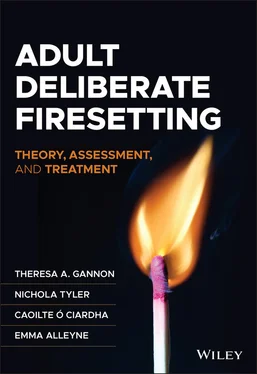Theresa A. Gannon - Adult Deliberate Firesetting
Здесь есть возможность читать онлайн «Theresa A. Gannon - Adult Deliberate Firesetting» — ознакомительный отрывок электронной книги совершенно бесплатно, а после прочтения отрывка купить полную версию. В некоторых случаях можно слушать аудио, скачать через торрент в формате fb2 и присутствует краткое содержание. Жанр: unrecognised, на английском языке. Описание произведения, (предисловие) а так же отзывы посетителей доступны на портале библиотеки ЛибКат.
- Название:Adult Deliberate Firesetting
- Автор:
- Жанр:
- Год:неизвестен
- ISBN:нет данных
- Рейтинг книги:5 / 5. Голосов: 1
-
Избранное:Добавить в избранное
- Отзывы:
-
Ваша оценка:
- 100
- 1
- 2
- 3
- 4
- 5
Adult Deliberate Firesetting: краткое содержание, описание и аннотация
Предлагаем к чтению аннотацию, описание, краткое содержание или предисловие (зависит от того, что написал сам автор книги «Adult Deliberate Firesetting»). Если вы не нашли необходимую информацию о книге — напишите в комментариях, мы постараемся отыскать её.
Explore the theoretical foundations of—and discover effective treatment options for—adults who deliberately set fires Adult Deliberate Firesetting: Theory, Assessment, and Treatment,
Adult Deliberate Firesetting: Theory, Assessment, and Treatment
Adult Deliberate Firesetting — читать онлайн ознакомительный отрывок
Ниже представлен текст книги, разбитый по страницам. Система сохранения места последней прочитанной страницы, позволяет с удобством читать онлайн бесплатно книгу «Adult Deliberate Firesetting», без необходимости каждый раз заново искать на чём Вы остановились. Поставьте закладку, и сможете в любой момент перейти на страницу, на которой закончили чтение.
Интервал:
Закладка:
Recently, Gannon et al. (in preparation), developed a comprehensive self-report tool to examine fire-related interests and attitudes. For a more detailed description of the measure, see Chapter 6. Factor analysis of responses from a large community sample, including individuals admitting deliberate firesetting, allowed the authors to parse fire-related attitudes more finely than earlier studies (e.g., Ó Ciardha et al., 2015b). All eight factors extracted from the measure differentiated between people admitting a history of firesetting and those who did not. Factors labelled as identification with fire , fire interest , pathological fire interest , coping using fire , and fascination with fire paraphernalia appear to reflect facets of fire interest. In a second study, Gannon et al.’s (in preparation) findings suggest that it is the coping using fire and identification with fire facets of fire interest that best differentiate between imprisoned men with and without convictions for firesetting.
Gannon et al. (2012) hypothesised that individuals who set deliberate fires may have developed cognitive scripts that facilitate firesetting (this theory was further developed by Butler & Gannon, 2015). Very little research has empirically tested the scripts of people who have set fires. Using a relatively small sample, Butler and Gannon (2021) found evidence of greater fire-related scripts and expertise among imprisoned men with current or previous firesetting offences compared with community and imprisoned individuals. Interestingly, fire-service personnel were indistinguishable from people who had set fires using Butler and Gannon’s measures of scripts and expertise, and both groups scored similarly on serious fire interest. Gannon et al.’s (in preparation) examination of the structure and correlates of a new measure of fire-related interests and attitudes provides additional evidence regarding firesetting scripts through the identification of coherent factors approximating two of Butler and Gannon (2015) hypothesised scripts: fire is a powerful messenger, and fire is soothing.
Offence-supportive attitudes.Gannon et al. (2012) hypothesised that adults who set deliberate fires would hold attitudes supportive of general offending and/or specific attitudes that would support criminal firesetting. Ó Ciardha and Gannon (2012) expanded on this hypothesis by proposing that people who set fires may have belief systems in the form of implicit theories (see Ward, 2000) that allow them to interact with their social words and process social information in an offence-supportive manner. We know of only one published study that has directly tested these hypotheses. Barrowcliffe et al. (2019) found only partial support for the specific hypotheses of Ó Ciardha and Gannon (2012) with a small sample of un-apprehended individuals (majority female) who had set fires. The findings of Gannon et al. (in preparation) also appear to support the suggestion by Ó Ciardha and Gannon (2012) that the belief that fire is a powerful tool may be characteristic of people who set fires as well as beliefs around how fascinating or exciting fire is.
Self and emotional regulation.The self- or emotion-regulation factors implicated in adult deliberate firesetting by the authors of the M-TTAF (Gannon et al., 2012) include issues with anger, poor coping or emotional expression, poor problem solving, and impulsivity. As mentioned, these factors may reflect clinical features of certain developmental disabilities or psychopathological disorders. However, they are not simply hypothesised as features of broader disorders but also as vulnerability factors in people who set fires in the absence of diagnosed mental ill health. Much of the older research on which these hypotheses were drawn relied on small samples or samples without comparison groups. Few studies have directly explored whether these factors distinguish groups of individuals who have set fires from other justice-involved individuals or the wider community. Gannon et al. (2013) compared imprisoned men with and without firesetting offences on a number of variables, including anger. They found that those with firesetting histories appeared to be characterised by more anger-related cognition (e.g., rumination and hostility) and physiological arousal to anger and had more experiences of anger as a response to perceived provocation. Findings by Alleyne et al. (2016) suggested that apprehended women who had set fires reported being more able to regulate their anger relative to other imprisoned women, although the effect size for this difference was small. Comparing a small sample of women and men who had set fires, Nanayakkara et al. (2020a) reported greater impulsivity and affect dysregulation among the female sample. Impulsivity also differentiated women who had set fires from other women admitted to a secure treatment setting (Long et al., 2015). Taking a different approach, Dalhuisen et al. (2017) examined the evidence for different subgroups of firesetting individuals. They concluded that some clusters of these individuals were characterised by self- or emotion-regulation factors such as coping problems or problems with impulsivity. Finally, Gannon et al. (in preparation) found that self and emotional regulation among people who set fires may be characterised by a reliance on fire as a method of coping or as a means to send a powerful message to others. These factors differentiated apprehended individuals with a history of firesetting from both apprehended and community controls.
Communication problems.Within the M-TTAF (Gannon et al., 2012), communication problems that are thought to act as vulnerabilities for firesetting include social skills issues, emotional loneliness, and low assertiveness. As with other factors, early research implicated these as characteristic of people who set fires (see Gannon & Pina, 2010), but a few more recent studies have demonstrated whether they are uniquely characteristic of this population. Gannon et al. (2013) did not find group differences between imprisoned men who set fires compared with those who did not on either assertiveness or loneliness using self-report measures. Alleyne et al. (2016) found that these social competence measures of loneliness and assertiveness did not differentiate imprisoned women who had set fires from other imprisoned women or from the men who had set fires. In one of few relatively recent studies that examined the social skills of people who have set fires, Hagenauw et al. (2015) reported lower social skills among the small sample of firesetting individuals in their comparison of mixed-gender individuals in a psychiatric institution. In a study that compared men apprehended for arson with men apprehended for violent offences and who were treated in an outpatient treatment centre, Wilpert et al. (2017) found that those apprehended for arson were more socially isolated.
Self-esteem.Self-esteem is conceptualised within the M-TTAF (Gannon et al., 2012; see Chapter 3) as a moderating factor, with intact or high self-esteem potentially protecting individuals against the deleterious effects of other psychological vulnerabilities that would otherwise place them at risk of offending. In this model, low self-esteem may exacerbate these risk factors. The best evidence of this relationship would demonstrate that self-esteem interacts with other risk factors preceding firesetting offending. However, evidence that individuals who engage in firesetting have lower self-esteem than comparison groups would provide partial support for this hypothesis. Two studies have reported significantly lower self-esteem among imprisoned men with a history of firesetting compared with imprisoned individuals (Duggan & Shine, 2001; Gannon et al., 2013). Analyses by Alleyne et al. (2016) has also suggested that while imprisoned women who set deliberate fires had lower self-esteem than men who set fires, they did not differ significantly from other imprisoned women (though see also Stewart, 1993). The possibility that gender may itself impact on a moderating role of self-esteem was suggested by Ducat et al. (2017).
Читать дальшеИнтервал:
Закладка:
Похожие книги на «Adult Deliberate Firesetting»
Представляем Вашему вниманию похожие книги на «Adult Deliberate Firesetting» списком для выбора. Мы отобрали схожую по названию и смыслу литературу в надежде предоставить читателям больше вариантов отыскать новые, интересные, ещё непрочитанные произведения.
Обсуждение, отзывы о книге «Adult Deliberate Firesetting» и просто собственные мнения читателей. Оставьте ваши комментарии, напишите, что Вы думаете о произведении, его смысле или главных героях. Укажите что конкретно понравилось, а что нет, и почему Вы так считаете.












